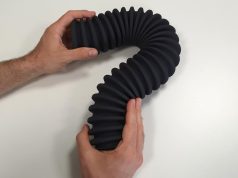EOS, world-leading manufacturer of laser-sintering equipment, will showcasing its innovative products at the Industrie show 2012 in Paris (March 26-30, 2012 in Paris Nord Villepinte) at booth 5H69. Here, EOS will present the EOSINT M 280, a further improved version of its market leading metal additive manufacturing system. Peter Klink, Executive Vice President Global Sales at EOS, states: „This system sets new standards in terms of part quality and reproducibility, at the same time improving cost-effectiveness and user-friendliness. The EOSINT M 280 adopts all features and advantages of the well-established EOSINT M 270 system, and makes it even more attractive for a wide range of demanding applications including tooling and series production.“
An additive layer manufacturing technology, DMLS differs significantly from the various molding or machining techniques like drilling, milling or grinding. It represents a new concept for the manufacturing of metal or polymer components. Limitations that often trouble conventional manufacturing methods are no longer an issue with laser-sintering. The technology offers a competitive alternative compared to conventional manufacturing processes if not even substituting them in some cases. With laser-sintering, the design drives the manufacturing process.
EOS pioneered direct additive manufacturing of metals in 1995 with the introduction of the EOSINT M 250 system. Since then EOS has continuously updated and further developed this product line which has gained a strong reputation for producing best quality parts. Numerous users, particularly in tooling, are already using EOS metal systems for series production in a variety of fields. Many other users are actively qualifying the technology for their production.
400 Watt laser for increased build speed and productivity
The new system EOSINT M 280 is available with either the same 200 Watt fiber laser which was pioneered by EOS with the EOSINT M 270, or with a 400 Watt fiber laser option. This higher power laser can melt more metal powder per second, thus achieving shorter build times and higher system productivity. For example, an injection molding core was built in less than half the time compared to EOSINT M 270. Especially for heavy use in a manufacturing environment, this enables significantly reduced costs-per-part, thereby increasing the competitiveness of laser-sintering compared to other technologies and opening up new viable application areas.
Increased build height expands applications range
Another improvement of the EOSINT M 280 compared to its predecessor is the increase of the maximum building height up to 325 mm. This enables taller parts to be placed in the process chamber, again expanding the application areas. This is particularly interesting for hybrid part building, a concept which EOS introduced in the 1990s for prototype tooling. In the hybrid process, complex parts are produced by building additional material on top of a prefabricated part.
Optimized gas management: robust process for increased reproducibility
Based on extensive process investigations and supported by fluid dynamics simulations, EOS has optimized the gas management system of the EOSINT M 280. A high-velocity laminar flow of protective gas across the entire build area, combined with the high-capacity recirculating filter system, ensures even more uniform process conditions. As a result, stable melting behavior is ensured even over long periods of time and with higher laser power. This results in further improved reproducibility of the part properties. The system therefore offers an excellent platform for further material and process developments. It also supports processes both under nitrogen gas atmosphere, created by compressed air via an integrated nitrogen generator, as well as under argon gas. Moreover, further improvements in the gas management system enable a reduction of the gas consumption and a prolonged filter lifetime, which further improve the cost-effectiveness and user-friendliness of the system.
Further system improvements
As with previous models, the system configuration can be adapted to different customer needs through a variety of options and accessories. The so-called Laser Power Monitoring (LPM) monitors the laser power during the building process and reports the compliance with the specifications or warns of any deviations. With the base module of the EOSTATE 1.2 software the machine status can be monitored. Additional EOSTATE modules Quality Assurance, Controlling and MPM (Machine Park Management) are also available. They allow a statistical overview of the built jobs and parts over freely selectable periods of time. Integrated Process Chain Management (IPCM) modules offer optimized powder and part handling, thus ensuring an increased productivity, quality and usability. These can be added at any time.
Subscribe to our Newsletter
3DPresso is a weekly newsletter that links to the most exciting global stories from the 3D printing and additive manufacturing industry.






















